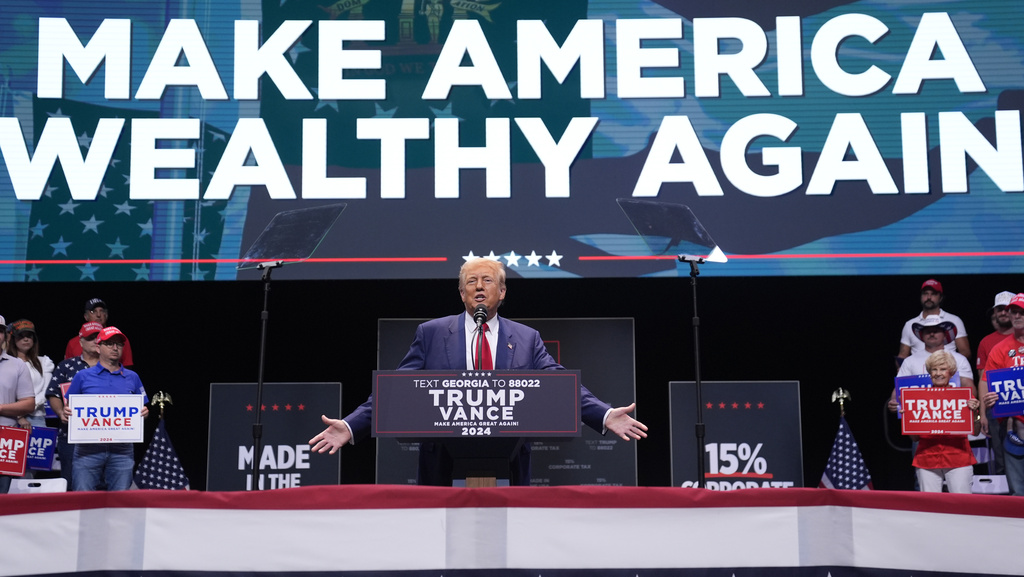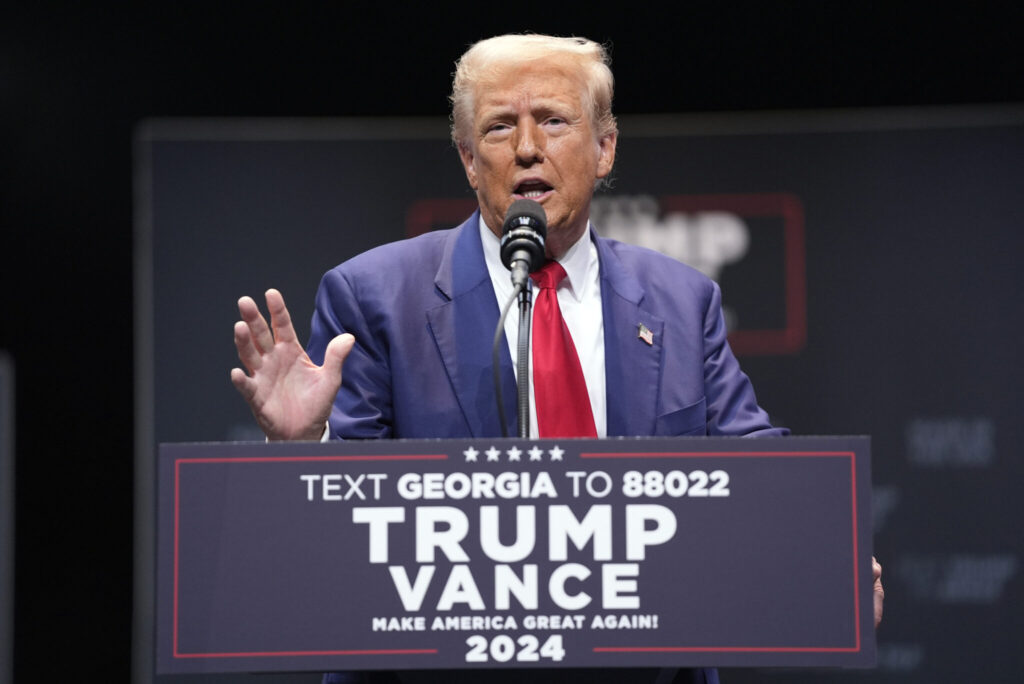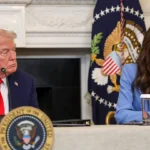Trump Vows to Boost U.S. Jobs, Proposes New Tariff and Tax Cuts \ Newslooks \ Washington DC \ Mary Sidiqi \ Evening Edition \ Donald Trump pledged to stop offshoring U.S. jobs and proposed a series of tariffs on foreign-made goods, despite warnings from economists about potential price hikes for consumers. Speaking in Georgia, Trump also promised corporate tax cuts for U.S.-based production, aiming to bring jobs and factories to America. His economic policies are central to his 2024 campaign as he challenges Vice President Kamala Harris, who advocates for higher corporate taxes and opposes his approach to tariffs.

Trump’s Jobs and Tariffs Plan: Key Takeaways
- Trump vowed to impose high tariffs on U.S. companies that move production abroad.
- He proposed cutting the corporate tax rate to 15% for companies that manufacture in the U.S.
- Trump’s tariffs could raise prices for U.S. consumers, according to economists.
- He plans to personally recruit foreign companies to invest in U.S. manufacturing.
- Trump’s past efforts to attract foreign investment, like Foxconn’s Wisconsin deal, fell short.
- He continues to criticize Kamala Harris for policies he says hurt U.S. industry.
Deep Look:
Donald Trump on Tuesday unveiled an ambitious economic plan in Savannah, Georgia, pledging not only to stop U.S. companies from offshoring jobs but also to attract jobs and factories from other countries. At the heart of his proposal were corporate tax cuts and tariffs aimed at revitalizing American manufacturing, a key message in his 2024 presidential campaign.
Trump, speaking at one of the busiest ports in the U.S., proposed reducing the corporate tax rate from 21% to 15%—but only for companies that produce goods domestically. He contrasted this with Vice President Kamala Harris’ proposal to raise the corporate tax rate to 28%. Under Trump’s presidency, the corporate tax rate was lowered from 35% to 21% in 2017. “We’re putting America first,” Trump declared, describing his vision of “new American industrialism” that he claimed would create “millions and millions of jobs.”
A major element of Trump’s plan is imposing tariffs on companies that outsource production. “If you don’t make your product here, then you will have to pay a tariff, a very substantial tariff, when you send your product to the United States,” Trump said, although he has yet to provide specific details about how this would work in practice.
While tariffs are designed to incentivize companies to manufacture in the U.S., economists have warned that they could lead to higher prices for American consumers. Tariffs on imports often result in cost increases that are passed on to consumers, potentially negating some of the benefits of bringing jobs back to the U.S.
Trump’s new proposals build on themes from his first presidency, but the former president has not yet answered key questions about the specifics of his plan. For example, it’s unclear whether his corporate tax cuts would apply to companies that assemble products domestically using imported materials. Additionally, his pledge to recruit foreign companies to the U.S. echoes promises he made during his first term, some of which failed to materialize. A high-profile example is Taiwan-based Foxconn, which pledged a $10 billion investment in Wisconsin and the creation of 13,000 jobs—a promise that ultimately fell short of expectations.
One controversial aspect of Trump’s economic plan involves offering foreign companies access to federal land as an incentive to invest in U.S. manufacturing. It remains unclear whether companies from countries like China would be excluded from such offers, especially given Trump’s long-standing rhetoric about China being detrimental to U.S. business interests. Trump’s campaign did not immediately respond to questions about this aspect of the plan.
Trump also aimed to boost U.S. auto manufacturing, declaring, “I want German car companies to become American car companies.” However, German automakers like BMW, Mercedes, and Volkswagen already have major production facilities in the U.S. Any further shift of foreign manufacturing to the U.S. would likely take years and could increase costs for American consumers, particularly in the auto industry.
Trump’s appearance in Savannah was his first in Georgia since a high-profile feud with Republican Gov. Brian Kemp came to a close in recent weeks. Kemp, who had previously clashed with Trump over the 2020 election, finally endorsed Trump for the 2024 race. Despite the endorsement, Kemp was notably absent from Tuesday’s event, underscoring lingering tensions within the Republican Party in Georgia.
Trump’s focus on Georgia highlights the importance of the state in the 2024 election. In recent months, political analysts have suggested that Georgia may become more competitive, particularly after Vice President Kamala Harris launched her presidential campaign following President Joe Biden’s decision not to seek re-election. Harris recently gave a speech in Atlanta, accusing Trump of being a threat to women’s rights and warning that his return to office would further restrict abortion access across the country.
During the event, Trump faced no shortage of vocal support from his Republican allies. U.S. Rep. Marjorie Taylor Greene, who was present in Savannah, introduced Trump as a “successful businessman” who provided “the best four years of our life.” Georgia Lt. Gov. Burt Jones also took the stage to defend Trump, criticizing Harris for calling Trump a threat to democracy. Jones himself has faced scrutiny for serving as a “fake elector” in the 2020 election, falsely attesting that Trump had won Georgia, though he avoided criminal charges in the matter.
Trump’s economic message also drew significant attention from local voters, many of whom continue to express strong support for his “America First” policies. Heather Mathis, a 43-year-old Trump supporter who attended the event with her daughter, said she believes the feud between Trump and Kemp will not affect the former president’s chances in the state. “Many people have personality differences. It doesn’t make any of them bad,” Mathis said. “Maybe they just don’t get along, and that’s OK.”
After outlining his economic plans in Savannah, Trump’s campaign will turn its attention to a rally in Indiana, Pennsylvania, where his running mate, JD Vance, is expected to join him later this week. Trump’s message of job creation, tariffs, and tax cuts is likely to remain a central theme as he continues to pitch himself as the candidate who can bring back American manufacturing and protect working-class voters from what he describes as damaging economic policies under the current administration.
Meanwhile, Harris continues to campaign in Georgia, where she and her running mate, Minnesota Gov. Tim Walz, have pushed back against Trump’s economic policies. At a recent fundraiser in New York, Walz criticized Trump’s “drill baby, drill” energy policy, calling it a “cheap and easy” approach that won’t address long-term challenges like climate change. Harris’ team has also accused Trump of harming small American farmers with his trade policies, which they claim led to record farm bankruptcies during his first term.
Despite these criticisms, Trump remains focused on his goal of revitalizing American industry, arguing that his tariffs and corporate tax cuts will bring jobs back to the U.S. His bold economic proposals, while popular among his base, continue to raise concerns about their potential costs for the broader economy.
Trump Vows Trump Vows Trump Vows







